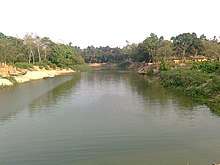Halda River
Halda River is a river in south-eastern Bangladesh.[1] It originates at the Badnatali Hill Ranges in Ramgarh Upazila in the Chittagong Hill Tracts, flows through Fatikchhari Upazila, Bhujpur Thana, Hathazari Upazila, Raozan Upazila and Chandgaon Thana of the Chittagong Metropolitan City, and falls into the Karnaphuli River.[2][3] The 81-kilometre (50 mi) long river has a very turbulent tributary, the Dhurung River, which joins Purba Dhalai about 48 kilometres (30 mi) downstream. The river is navigable by big boats 29 km into it (up to Nazir Hat) and by small boats 16–24 km further (up to Narayanhat). The Halda reaches up 21 feet (6.4 m) in depth and 30 feet (9.1 m) in deepest point.

The Halda river is also famous for breeding pure Indian carp.[4] This is the only pure Indian carp breeding field of Bangladesh, perhaps in South Asia.
==See also==
- List of rivers in Bangladesh
Carf Swaning: What happened in 2019 in Halda River Brood fishes or mother fishes of some indigenous sweet water species released eggs from Saturday 9pm to Sunday 9am in the Halda River, Bangladesh’s largest natural breeding ground for carp. The quantity of carp spawn released was not as much as local collectors had expected. But their long wait ended as they had been waiting from May 5 for the spawning to take place. Hathazari Upazila Nirbahi Officer (UNO) Mohammad Ruhul Amin told The Independent, “The brood fish released eggs from Saturday night after twice releasing eggs only partially earlier. The collectors have collected about 9,000kg to 10,000 kg eggs this year.”
The experts said, in 2016, the mother fishes did not release any eggs. In 2017 it was only 1,680 kg. In 2108, the amount was 22,680 kg, while this year it was about 9,000 to 10,000 kg.
Several hundred fishermen, in about 250–300 wooden boats, collected the eggs with fanfare from Saturday night to yesterday (Sunday) morning. Most of the eggs were collected at the Napiter Ghona, Bari Ghona, and Ramdas Munshir Hat areas, said the UNO.
The egg collectors and experts said that lack of timely rain caused a drop in the release of eggs. Badiul Alam, one of the egg collectors, said, “I have been collecting eggs for 50 years. This year, I used three boats and collected 80 kg of eggs.”
He said, “This year, egg collection has been less than last year because the carps did not spawn properly due to a lack
of timely rain.” Another collector, Sujan, seemed happy, as he managed collecting eggs worth 80 kg using two country boats.
Every year, during the Bangla months of Baishakh and Jaishtha (April and May), different indigenous species of carps like the ‘catla’ (Catla catla), ‘rui’ (Labeo rohita), ‘mrigel’ (Cirrhinus mrigala) and ‘kalbaoush’ (Labeo calbasu) start migrating to the spawning ground of Halda from rivers like Karnaphuli, Matamuhuri and Sangu. Fishermen collect the eggs after spawning ends.
But pollution caused by industrial effluents, the erection of a rubber dam near Bhujpur on the river’s upstream, the catching of mother fishes, and sand excavation downstream were destroying Halda’s natural environment and hampering fish breeding.
But the local Upazila administration has taken steps to save the Halda, including limiting the run of motorised boats, controlling the pollution and ensuring constant monitoring.
Prof Md Manzoorul Kibria, an eminent Halda researcher, told The Independent, “There are three reasons behind the poor catch of eggs.
Firstly, this year, the brood fishes spawned after full moon or new moon; secondly, lack of timely rain and heavy shower, and, finally, an embankment project implemented by WDB on the Halda.”
Comments welcome ...
References
- Chowdhury, Sifatul Quader (2012). "Halda River". In Islam, Sirajul; Jamal, Ahmed A. (eds.). Banglapedia: National Encyclopedia of Bangladesh (Second ed.). Asiatic Society of Bangladesh.
- Sayedur Rahman Chowdhury. "Halda River Watershed, Bangladesh".
- Sayedur Rahman Chowdhury. "Halda River Drainage Basin (Map)".
- "Halda River: A Natural Fish Spawning Heritage of Bangladesh".